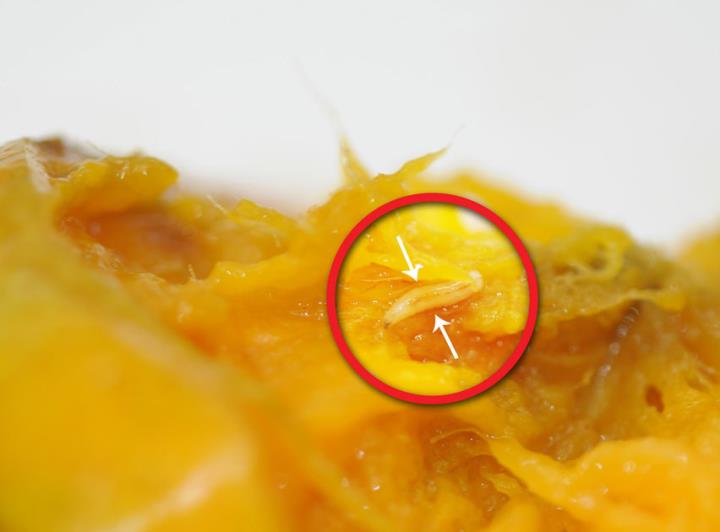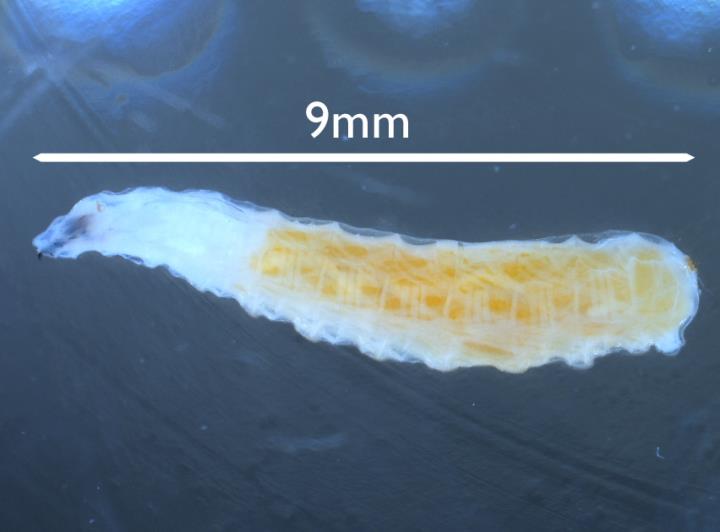The discovery of fruit fly adults and larvae at several sites in northern Tasmania and on Flinders Island has sent a chill through the state. Fruit fly is a serious pest of soft fruit though out much of mainland Australia but was not present in Tasmania.

Queensland fruit fly © DPIPWE TAS
The first fruit flies were found in late January on Flinders Island. Since then fruit fly has also been detected at several sites in north-west and north-east Tasmania and the possible source of infected fruit has been traced back to a fruit processing and treatment plant in Victoria although so far tests have not discovered in breaches in treatment.
Tasmania’s fruit-fly-free status opens up trade opportunities particularly with Asia and makes growing top quality fruit accessible to all gardeners. To keep Tasmania’s fruit-fly-free status Tasmanians and visitors must take this state’s quarantine restrictions seriously. Tasmania’s strict quarantine restrictions often come as a surprise to visitors but breaking them can have serious results. For a full list of what’s not allowed into the island state click here.
As well as controls over the movement of fresh fruit into Tasmania, a Fruit Fly Infected Area has been declared around the detection sites with a Fruit Fly Control Area established as a 15km zone around sites where fruit fly adults and larvae have been discovered. Warning signs and quarantine bins are in place around the zones. Whole host fruit from within the Control Area cannot be taken outside the area however chopped, sliced or cooked fruit can be taken outside the zone.
Tasmania is not the only fruit-fly-free area experiencing incursions of fruit fly this summer. Outbreaks have also been experienced in South Australia and Victoria.
Given the recent fruit fly outbreaks it’s wise to keep an eye out for signs of fruit fly in fresh fruit from gardens, friends, roadside stalls, produce swaps, markets and from fruit shops and supermarkets. Fruit fly activity is at its peak in warm weather in late summer.
What to look for
As this pest isn’t familiar to most gardeners in Tasmania, South Australia and Victoria, here’s what to look for. Adults are large but elusive flies that are difficult to spot. Rather than looking for flies, concentrate on looking for larvae in fruit.

Fruit fly larva in flesh © DPIPWE TAS
As fruit flies are flies, they start life as maggots. These small creamy white writhing larvae hatch in soft fruit. Affected fruit may include apricot, peach, nectarine, plum, cherry, fig, feijoa, some citrus including grapefruit and mandarin and berries including raspberry. Salad vegetables that are actually fruit are also highly vulnerable to fruit fly including chilli, capsicum and tomato.
There is also concern about the ripening apple and pear crops, which may be attacked. Root vegetables are not affected.
As the female fruit fly prepares to lay eggs she makes a pinprick hole in ripe fruit, piercing the skin. These are called ‘stings’ and are seen as tiny dots on fruit skin. They may be the first indication that fruit fly is present.

Fruit fly larva © DPIPWE TAS
The maggots hatch and begin to feed and grow in the fruit. While infected fruit may look okay from outside it will have rotten brown patches and maggots inside. In a few days the entire piece can rot and fall to the ground. The maggots are much smaller and smoother than caterpillars such as codling moth larvae that may also be found in fruit.
Maggots flip and wriggle themselves out of the fruit and into the ground under the fruit tree where they pupate and emerge as adults. The entire life cycle from egg to newly minted adult can take just four weeks, which is why the pest spreads so rapidly.
Two fruit flies are pests in Australia. The one that has been positively identified in Tasmania is Queensland fruit fly (QFF). This is a native pest, which has spread south from Queensland into New South Wales with incursions into Victoria and South Australia.
The other is the Mediterranean fruit fly (also called medfly) an introduced pest from Europe found in Western Australia in the late 19th century. It is also occasionally discovered in South Australia.
Don’t confuse the pest fruit fly with the vinegar fly (sometimes referred to as a fruit fly or drosophila). This is the tiny fly that may be found swarming around ripe fruit in the fruit bowl in the kitchen or hovering around the compost. It does not pose a threat to fresh fruit as it is attracted to decaying fruit.
Fruit fly control and who to call
Baits and lures and, on the mainland, the release of sterile males, are methods used to control fruit fly. The chemicals used kill the fruit fly but are not harmful to us. They cause minimum damage to beneficial insects such as bees.
The baits are clever and work on the female fruit fly’s need to feed on protein before she can mature and lay eggs. The control uses protein baits that include the biological insecticide spinosad. The bait attracts the female to feed before she lays any eggs. As she eats the bait she is killed by the spinosad and so no eggs are laid in fruit. These baits do not kill fruit fly larvae.
A trap known as a Q-Fly trap, contains a pheromone that lures the male fruit fly. The trap is an indicator rather than a control measure. The presence of male fruit fly in a Q-fly trap indicates that an active population is present and controls are needed.
If you live in Tasmania and find fruit fly maggots in fruit in your garden or buy or are given fruit you suspect contains fruit fly, put the fruit in a sealed bag or container and in a second sealed bag and call the Biosecurity Tasmania hot line on (03) 6165 3774. Do not put it in the compost heap or green waste recycling bins.
Find out more
For more information and updates see the Biosecurity Tasmania website.
